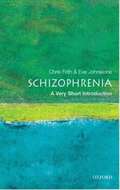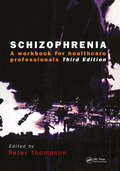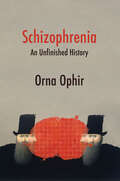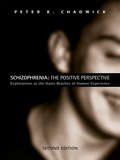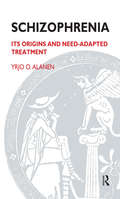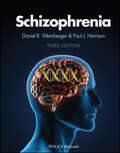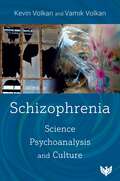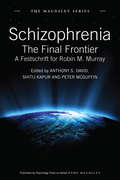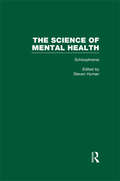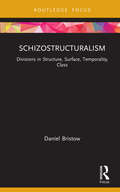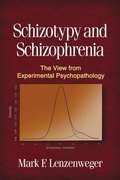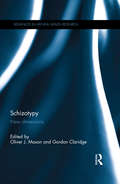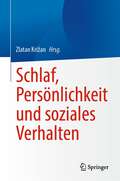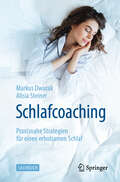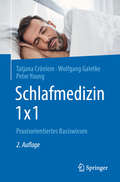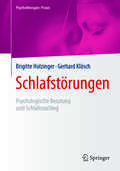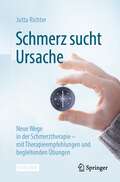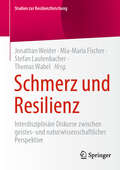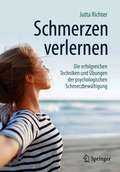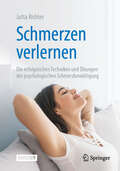- Table View
- List View
Schizophrenia: A Very Short Introduction
by Christopher Frith Eve C. JohnstoneSchizophrenia is the archetypal form of madness. Schizophrenia is a common disorder and has a devastating effect on sufferers and their families-patients typically hear voices in their heads and hold bizarre beliefs. The schizophrenic patient presented to the public in sensational press reports and lurid films bears little resemblance to reality of the illness. This book describes what schizophrenia is really like, how the illness progresses, and the treatments that have been applied. It also summarizes the most up-to-date knowledge available about the biological bases of this disorder. Finally it attempts to give some idea of what it is like to have schizophrenia and what this disorder tells us about the relationship between mind and brain.
Schizophrenia: A Workbook for Healthcare Professionals
by Peter ThompsonThe quality of health care in the US depends on the patient's ability to pay and his or her insurance cover, at an annual cost of $3600 per head of population. In the UK, the quality of care costs less at an annual cost of $1000 per head of population, although care is sometimes delayed through a lack of resources. This book compares the two systems from the viewpoint of primary care, identifying some models of excellence from which both can benefit. It draws on the experience of the NHS reforms in the UK and the political imperative to control costs and improve the service in the US.
Schizophrenia: An Unfinished History (History of Health and Illness)
by Orna OphirThroughout the world, schizophrenia is a diagnosis now in decline, representing a radical shift in our historical and medical understanding of madness and mental distress. But what does this medical term, first coined by a Swiss psychiatrist in 1908, mean? And why is it increasingly unpopular among patients and the medical establishment? Historian and clinician Orna Ophir unearths the stories of patients and doctors as they struggle to make sense of this debilitating condition. At different times, patients have been depicted as possessed by demons, or simply “inspired,” as hearing voices, suffering from a “split-mind,” or merely having difficulty in “integrating” experiences. Now, a century after its birth, schizophrenia is increasingly viewed not as a radical, abnormal disease defined by an ever-changing cluster of symptoms, but the extreme end of a spectrum on which we are all located. The story Ophir tells is a hopeful one: As patients and doctors sought to overcome stigma and improve therapeutic outcomes, they have shown ever-greater sensitivity to diversity and difference. Schizophrenia: An Unfinished History gestures toward a future in which clinicians and patients will collaborate in the search for better outcomes.
Schizophrenia: Explorations at the Outer Reaches of Human Experience
by Peter Chadwick Peter K. ChadwickThis fully revised second edition of Schizophrenia: The Positive Perspective uses biographical sketches and essays to discuss schizophrenia and related conditions, providing advice on methods of coping, routes to growth, recovery and well-being, and how schizophrenia can be viewed in a positive light. It also explores the insights of R.D. Laing and discusses how they can be applied to contemporary ideas and research. In this expanded edition Peter Chadwick, a previous sufferer, builds on his earlier edition and introduces new topics including: Cannabis smoking and schizophrenia. Psychoanalytic approaches to psychosis and their extension into the spiritual domain. Using cognitive behaviour therapy in the treatment of profound existential distress. How experiences on the edge of madness can be relevant to understanding reality. Schizophrenia: The Positive Perspective encourages hope, confidence and increased self-esteem in schizophrenia sufferers and raises new questions about how schizophrenia should be evaluated. It is important reading for anyone working with schizophrenic people including psychologists, psychiatrists, social workers, and other mental health professionals.
Schizophrenia: Its Origins and Need-Adapted Treatment (Monograph Series On Schizophrenia)
by Yrjo O. AlanenThis book includes memorable case vignettes along with research findings and is recommended for clinicians, students, teachers of mental health and those in public policy involved in creating effective treatment methods.
Schizophrenia: Progress And Interpretation
by Paul J. HarrisonSchizophrenia is one of the most complex and disabling diseases to affect mankind. Relatively little is known about its nature and its origins, and available treatments are inadequate for most patients. As a result, there are inevitable controversies about what causes it, how to diagnose it, and how best to treat it. However, in the past decade, there has been an explosion of new research, with dramatic discoveries involving genetic etiology and epidemiological risk factors. There has also been a catalog of new drugs coming to market, and controversy about the relative advantages and disadvantages of newer compared with older therapies. In addition, developing technologies in genomics, molecular biology and neuroimaging provide streams of new information. This book represents a definitive, essential, and up-to-date reference text on schizophrenia. It extensively and critically digests and clarifies recent advances and places them within a clinical context. The Editors (one American and one British), highly respected clinical psychiatrists and researchers and acknowledged experts on schizophrenia, have again assembled an outstanding group of contributors from the USA, UK, Europe and Australia, It will be of value to practising psychiatrists and to trainees, as well as to clinical and neuroscience researchers interested in keeping up with this field or coming into it. The book consists of four sections: descriptive aspects, biological aspects, physical treatments, and psychological and social aspects. It reviews the theoretical controversies over symptomatology, classification and aetiology (particularly pertinent as DSM-V is being developed), the relationship of schizophrenia to the other psychoses, the significance of positive and negative symptoms and pre-morbid personality. It describes a variety of approaches to integrating the vast research data about schizophrenia, including neurodevelopmental, genetic, pharmacological, brain imaging and psychological findings. The biological treatment section reviews the comparative efficacy of various drugs, the management of drug-resistant patients and both neurological and metabolic complications. The final section looks at psychological therapies, social outcomes, and the economics of schizophrenia. Highly Commended in the Psychiatry section of the 2012 BMA Book Awards.
Schizophrenia: Science, Psychoanalysis, and Culture
by Vamik Volkan Kevin VolkanKevin Volkan and Vamik Volkan present a comprehensive study of schizophrenia using a psychoanalytic lens on the existing interdisciplinary research. Over the last seventy years, mainstream research on the causes, prevalence, and treatment of schizophrenia has greatly diverged from psychoanalytic thinking. However, the emergence of the field of neuropsychoanalysis brings hope that psychoanalytic metapsychology and clinical theory may once again provide valuable insight into understanding schizophrenia. Psychoanalytic treatment may not be appropriate for many sufferers but psychoanalysis does provide insight to inform and improve treatment. It can also illuminate what aspects of schizophrenia are common across cultures, where they present unique characteristics, and just how cultural variations occur. For any future improvement in understanding and treating schizophrenia, the cultural underpinnings and expressions of schizophrenic illness need to be made clear. For clinicians in the field, the authors' aim is to deepen insight and promote the use of psychotherapy and integrated treatments, while increasing sensitivity to cultural variations in schizophrenic disease. Accordingly, this book is divided into four sections. The first gives a brief overview and outline of the mainstream understanding of schizophrenia. The second drills down to focus on general psychoanalytic ideas about schizophrenia, culminating with a focus on problems with early object relations. The third looks at how psychoanalytic treatment can be successful in some cases. The fourth and final part discusses how views of the disorder and the disorder itself are affected by culture. The authors hope to generate insight and understanding of schizophrenic disorders which could lead to new approaches to treating and possibly preventing schizophrenia. It is a must-read for all clinicians and trainees working in the field and presents interesting ideas to anyone with an interest in the subject.
Schizophrenia: Seven Approaches
by George WillisonSeven controversial approaches to schizophrenia, each assuming a distinctive model, biological, psychological, or social, are presented by their leading exponents. Arnold and Edith Buss deal with such fundamental issues as: What is the nature of schizophrenia? What general approach does each theory represent? What does each theory assume, what evidence does it require for proof, and what follows if the theory is correct? While the various approaches covered here have many differences and few similarities, they are not all mutually contradictory, and several may be combined into a larger synthesis.From a biological point of view, schizophrenia is a disease like any other, originating in heredity, tissue malformation, and physiological abnormality. The biological approach is represented here by a theory focusing on genetic and neurological aspects. The psychological approach treats schizophrenia as a failure of adjustment. Within this framework there is considerable disagreement. One theory emphasizes the cognitive problems of perceiving, thinking, and problem-solving; another centers on motivational disturbance, with its attendant problems of anxiety and withdrawal; and two theories focus on regressive behavior.Schizophrenia provides a stimulating basis for discussion by presenting the etiology of schizophrenia in terms of the most significant contemporary approaches. The juxtaposition of these viewpoints enables the professor to maximize students' interest as well as their insight into the complexity of contradictory evidence and opinions.
Schizophrenia: The Final Frontier - A Festschrift for Robin M. Murray (Maudsley Series)
by Shitij Kapur Anthony S. David Peter McGuffinSchizophrenia is a unique project reflecting the contribution that Robin M. Murray has made to the field of psychiatry over the past 35 years, with a particular focus on the advances that have been made to the understanding and treatment of schizophrenia. International contributors have been brought together to pay tribute to Robin Murray’s work and explore the latest findings in the area. Sections cover: neurodevelopment neuroscience and pharmacology neuroimaging genetics cognition social psychiatry treatment. This book will be essential reading for psychiatrists, clinical psychologists, social and basic scientists whose work is related to major mental illness, as well as admirers of the work of Robin Murray.
Schizophrenia: The Science of Mental Health
by Steven HymanFirst published in 2002. Routledge is an imprint of Taylor & Francis, an informa company.
Schizophrenic Women: Studies in Marital Crisis
by Harold Sampson Sheldon L. Messinger Robert D. TowneSchizophrenic Women is a fascinating report on the lives of seventeen families that suffered the experiences associated with the hospitalization of the wife and mother for mental illness. A description and analysis of representative experiences is presented here in an attempt to investigate various key issues--the patterns of family living preceding the crisis leading to medical hospitalization; how the patterns fell apart; how personal and family crises became psychiatric emergencies; how the hospital experiences modified both the immediate crises and the earlier patterns of living--and how durable those changes were once the patients had returned home. The book goes beyond the immediate lives of the women and their families--the authors direct attention to patterns of psychiatric care and to the ways in which such crises as those experienced by these women and their families come to professional attention and are managed. The authors explore how help is found and used and some of the functions hospitalization serves for patients and their families. They point out some of the ways that traditional patterns of psychiatric care limit the power to observe, understand, and effectively influence a pathological course of events. In her new introduction to Schizophrenic Women, Rita J. Simon notes that, "Although the study was conducted in the 1950s, readers will recognize its current relevance and importance for scholars and the lay public interested in the problem of mental illness and intrafamily relationships."
Schizophrenie
by Helmut Remschmidt Frank TheisenWohl kaum eine psychische Störung wirft so viele Fragen auf wie die schizophrenen Störungen. Und wohl wenige Störungen können so entscheidend das gesamte Leben beeinflussen. Patienten tragen das Stigma einer Schizophrenie mitunter ein Leben lang mit sich herum. Eine zweifelsfreie Diagnostik und eine adäquate Therapie sind hierbei entscheidend. Helmut Remschmidt und Frank Theisen setzen hier mit ihrem Werk Maßstäbe - Übersichtlich - Praxisrelevant - Handlungsorientiert - Leitlinienkonform Für Kinder- und Jugendpsychiater, psychologische Psychotherapeuten für Kinder und Jugendliche, Pädiater, Pädagogen und alle, die mit jungen Patienten mit psychischen Störungen konfrontiert werden. Die Reihe "Manuale psychischer Störungen im Kindes- und Jugendalter" verfolgt drei wesentliche Ziele: Interdisziplinärer Ansatz: Der Patient steht im Mittelpunkt - der Therapeut muss sein Bestes geben, die Störung zu diagnostizieren und adäquat zu behandeln. Psychiater und Psychologen sind hier gefordert, ihr Wissen beizutragen und über den Tellerrand zu blicken. Praxisrelevanz: Alle Theorie ist grau - diese Reihe gibt Ihnen die Tipps und Tricks an die Hand, mit denen Sie Ihren schwierigen Alltag ein bisschen besser meistern können. Didaktik und Struktur: Alle Bände sind gleich strukturiert und warten mit einer übersichtlichen Didaktik auf. Das Lesen soll Spaß machen und die entscheidenden Informationen müssen schnell erfasst werden können.
Schizostructuralism: Divisions in Structure, Surface, Temporality, Class
by Daniel BristowSchizostructuralism draws together insights from psychoanalytic, structuralist, and Marxist theory, and the divisions and antagonisms that both underpin and distinguish them, to form a new psychoanalytic system. Working through the key concepts and methods in these fields, Daniel Bristow describes the processes of unification and separation inherent in structure; extends concepts within the field of psychoanalytic topology and its study of surface; and interrogates types and phasings of time that operate psychosocially, testing workings of these against analyses of class division and struggle. Returning to and working through key concepts and methods in the fields of structuralism, topology, temporality, and Marxist political theory, Schizostructuralism looks again at such major figures as Freud, Reich, Lacan, Laing, and Deleuze and Guattari—invoking their socially oriented theories and practices—and sets out possibilities for recalibrating critical and clinical approaches to be more politically radical and inclusive. Bristow draws on an array of schematic diagrams, depicting and formulating the clinical categories of neurosis, perversion, and psychosis. Schizostructuralism will be of interest to academics and students of psychoanalytic studies, Lacanian studies, and philosophy. It will also inform psychoanalysts in practice and in training.
Schizotypy and Schizophrenia: The View from Experimental Psychopathology
by Mark LenzenwegerThis compelling book argues that all people with schizophrenia share a personality organization known as schizotypy. Presented is a novel framework for understanding schizophrenia through the study of individuals who may never develop the disorder, but who nonetheless harbor a liability for it. Mark F. Lenzenweger comprehensively reviews current knowledge about schizotypy while exploring broader questions of how to think about and conduct psychopathology research, making the book useful and relevant for both researchers and students. He demonstrates state-of-the-art strategies for combining clinical observations, psychometric and psychophysiological measures, neuroimaging, and genetic analyses, and for analyzing the results using advanced statistical techniques.
Schizotypy: New dimensions (Advances in Mental Health Research)
by Oliver Mason Gordon ClaridgeFor several decades there has been an increasing move towards viewing the psychotic illnesses from a dimensional perspective, seeing them as continuous with healthy functioning. The idea, concentrating mostly on schizophrenia, has generated considerable theoretical debate as well as empirical research, conducted under the rubric of 'schizotypy'. This book offers a timely discussion of the most significant themes and developments in this research area.Divided into four key sections which represent current concerns in schizotypy research – Measurement, Brain and Biology; Development and Environment; Consequences and Outcomes; and Future Directions – chapters reflect a broad range of approaches and discuss varied theoretical perspectives on schizotypy. Topics include: cognitive and perceptual biases psychometric assessments creativity and schizotypy genetic associations. developmental perspectives Schizotypy: New dimensions will appeal to academics, researchers and postgraduate students in the area of psychotic illnesses, as well as professionals including psychiatrists and clinical psychologists who are concerned with the basis of serious mental disorder. The book will inform readers who are new to the topic and will update and expand the knowledge base of those more experienced in the field.
Schlaf, Persönlichkeit und soziales Verhalten
by Zlatan KrižanDas Ziel dieses Buches ist es, einen Überblick über das begrenzte wissenschaftliche Wissen darüber zu geben, wie Schlaf mit Persönlichkeit und Sozialverhalten zusammenhängt. Dieser Sammelband begründet ein neues interdisziplinäres Forschungsfeld zum Thema Schlaf, das Schlafprozesse im Zusammenhang mit sozialem Verhalten und sozial-kognitiven Prozessen (z. B. mögen, respektieren, helfen, verletzen, erreichen) sowie individuellen Unterschieden in der Persönlichkeit (d. h. chronische Muster von Gefühlen, Gedanken und Verhalten) untersucht. Die Autoren zeigen die wichtigsten Lücken in den wissenschaftlichen Erkenntnissen über den Schlaf und seine Bedeutung für persönlichkeitsbezogene und soziale Prozesse auf und wollen damit die künftigen Forschungsbemühungen von Wissenschaftlern aus den Bereichen Psychologie, Biologie, Soziologie und Schlafmedizin unterstützen.Zu den diskutierten Themen gehören:· Wie der Schlaf die Emotionsregulation beeinflusst· Schlaf und Temperament in der frühen Kindheit· Dynamik zwischen Schlaf und Selbstbeherrschung· Auswirkungen auf die Aufgabenerfüllung· Einfluss des Schlafs auf soziale Kognition und Urteilsvermögen'Schlaf, Persönlichkeit und soziales Verhalten' untersucht umfassend die Rolle des Schlafs bei Emotionen und Motivation, die Auswirkungen des Schlafs auf sozial-kognitive Prozesse, die Dynamik zwischen Schlaf und dem Funktionieren von Beziehungen, die Bedeutung des Schlafs für das Gruppenverhalten, die Rolle von Persönlichkeitsunterschieden beim Schlaf und die Rolle des Schlafs bei der Persönlichkeits- und Sozialentwicklung. Forscher aus den Bereichen Persönlichkeits- und Sozialpsychologie, Gesundheitspsychologie und Neurologie werden in diesem aufschlussreichen Buch die erheblichen Lücken im wissenschaftlichen Verständnis des Schlafs aufdecken.
Schlafcoaching: Praxisnahe Strategien für einen erholsamen Schlaf
by Markus Dworak Alisia SteinerWir schlafen 1/3 unseres Lebens – und das aus gutem Grund. Der Schlaf ist die zentrale Erholungsperiode für Körper und Geist und damit eine wichtige Voraussetzung für die Gesundheit und das Wohlbefinden. Im heutigen (Berufs-)Alltag, der sich zunehmend durch Stress, Bewegungsmangel, ungesunde Ernährung und digitalen Medienkonsum auszeichnet, kommt der Schlaf häufig zu kurz. Immer mehr Menschen leiden unter Schlafstörungen und haben verlernt, wie sie einen gesunden Schlaf finden. Ein professionelles Schlafcoaching kann für viele Menschen der Schlüssel zurück zu einem erholsamen Schlaf und einem gesünderen Alltag sein. Dieses Buch vereint aktuelles fundiertes Wissen aus der Schlafforschung mit direkten praktischen Empfehlungen und Tipps für ein ganzheitliches Schlafcoaching. Neben grundlegenden Einblicken in die Funktions- und Wirkungsweise des Schlafs wird auf zahlreiche Einflussfaktoren eingegangen, die den Schlaf fördern oder stören können, wie z. B. körperliche Aktivität, Ernährungsgewohnheiten, Medienkonsum und Abendroutinen. Mit anschaulichen Beispielen, praxisnahen Empfehlungen und Tipps zur Gestaltung der eigenen Coachingtätigkeit, die dabei helfen, als Schlafcoach durchzustarten und ein erfolgreiches Schlafcoaching in der Praxis zu etablieren.
Schlafmedizin 1x1: Praxisorientiertes Basiswissen
by Peter Young Tatjana Crönlein Wolfgang GaletkeLeitlinienorientiert und basierend auf den neuesten Standards der Schlafmedizin: Diagnostische und therapeutische Hilfen bei allen Formen von Schlafstörungen. Praxisnah und übersichtlich von einem interdisziplinären renommierten Autorenteam der Schlafmedizin. Das Wichtigste zum schnellen Nachschlagen für die Praxis.Gestörter Schlaf und Tagesmüdigkeit sind häufige Beschwerden in der ärztlichen Praxis. Unbehandelt bergen sie ein erhöhtes Risiko für Unfälle und kardiovaskuläre Erkrankungen. Das gezielte Erkennen von Schlafstörungen wie die Insomnie, das Schlafapnoe-Syndrom, Parasomnien oder Hypersomnien gehört inzwischen zum Alltag der ärztlichen Praxis. Die Schlafmedizin bietet eine Bandbreite an diagnostischen Verfahren über das Schlaflabor hinaus und störungsspezifische Therapiemöglichkeiten. Guter Schlaf ist ein integrativer Bestandteil der psychischen und körperlichen Gesundheit. Mit Informationsmaterial für Patienten, Fragebögen, Fallbeispielen.
Schlafstörungen
by Brigitte Holzinger Gerhard KlöschDieses Buch vermittelt Basiswissen zu Schlafcoaching, einem integrativen psychotherapeutischen Ansatz zur nichtmedikamentösen Behandlung von Schlafproblemen. Dargestellt werden Grundlagen der Schlaf- und Traumforschung sowie die wichtigsten Schlafstörungen und deren Behandlungsmöglichkeiten. Der inhaltliche Schwerpunkt liegt bei der Planung und Durchführung von psychologischen Behandlungskonzepten bei Schlafstörungen (Schlafedukation, Elemente der kognitiv-behavioralen Therapie, Gestalt- und Hypnotherapie, Gesprächsführung und Albtraumbewältigung).Geschrieben für Psychotherapeuten, Gesundheitsberater, Psychologen, Ärzte, Pflegewissenschaftler, biomedizinische Fachkräfte. Inhaltlich ist das Buch abgestimmt auf den postgraduellen Zertifikatskurs Schlafcoaching an der Medizinischen Universität Wien.
Schlafstörungen ganzheitlich behandeln: Komplementäres Therapiekonzept für Ärzte und Psychotherapeuten
by Carolin Marx-DickDas Buch vermittelt übersichtlich ein vollständiges ganzheitliches Therapiekonzept zur Behandlung von Schlafstörungen und führt damit das Vorgängerwerk "Nichtorganische Schlafstörungen" der Autorin inhaltlich und methodisch weiter. Ausgehend von der Wissensvermittlung zu den Funktionen des Schlafes und evidenten Folgen von Schlafstörungen, beschreibt Carolin Marx-Dick die multimodale Behandlung im Sinne der Mind-Body-Medizin mithilfe von kompakten und praxiserprobten Handlungsanweisungen, u.a. mit achtsamkeitsbasierten Therapietechniken, körpertherapeutischen Elementen, Ernährungs- und Bewegungstherapie und naturheilkundlichen Behandlungsansätzen. Zum Download werden Arbeits- und Patientenmaterialien zur Verfügung gestellt, die eine unkomplizierte und kurzfristige Anwendung der Therapiemethoden ermöglichen. Übersichtstabellen geben den Behandelnden eine schnelle Orientierung zur Diagnostik, Therapieplanung und Einsatz gezielter Therapiebausteine. Alle vorgestellten Methoden haben sich in der Behandlungspraxis bewährt und können Patienten in die Lage versetzen, ihre Gesundheit dauerhaft aufrecht zu erhalten.
Schlüsselkompetenz personale Kontrolle: Berufliche Bildung erfolgreich gestalten
by Michaela HeineckeUnternehmen und ihre Mitarbeiter schauen heute hoffnungsvoll auf Schlüsselkompetenzen. Die Fähigkeit, sich weiterzuentwickeln, ist ausschlaggebend für den Erfolg ganzer Volkswirtschaften geworden. Was können Personalentwickler und Bildungsverantwortliche in der Aus-, Fort- und Weiterbildung dafür tun? Personale Kontrolle ist die Schlüsselkompetenz, die den Zugang schafft. Handlungsnah, ökonomisch und doch auf alle Lebensbereiche übertragbar, hilft Personale Kontrolle nicht nur beim Erreichen von Unternehmens- und Karrierezielen. Sie reguliert das selbständige Lernen im Alltag, beim Blended Learning und auch in Krisenzeiten. Empirische Studien zeigen außerdem: Wer personale Kontrolle gezielt fördert, der eröffnet den Weg in eine Erfolgsspirale des Lernens.
Schmerz sucht Ursache: Neue Wege in der Schmerztherapie – mit Therapieempfehlungen und begleitenden Übungen
by Jutta RichterSie leiden an chronischen Schmerzen und möchten verstehen, woher diese kommen und was Sie dagegen tun können? Blicken Sie hinter das Offensichtliche und erfahren Sie, wie die Entwicklungen in der Kindheit, familiäre Beziehungen, generationsübergreifende und traumatische Erfahrungen körperliche Schmerzen verstärken, aufrechterhalten und sogar verursachen können. Lesen Sie, welche Therapiekonzepte aus Hypnotherapie, Trauma- und systemischer Therapie, aus psychodynamisch und körperorientierten Konzepten erfolgsversprechend sind und was Sie selbst tun können, um Ihre Schmerzen erfolgreich zu reduzieren. Ein wertvoller Ratgeber für Betroffene, aber auch Ärzte und Therapeuten, die moderne Forschungsergebnisse aus der Traumaforschung, der psychosomatischen Medizin und Epigenetik in ihre tägliche Arbeit integrieren möchten.
Schmerz und Resilienz: Interdisziplinäre Diskurse zwischen geistes- und naturwissenschaftlicher Perspektive (Studien zur Resilienzforschung)
by Stefan Lautenbacher Jonathan Weider Mia-Maria Fischer Thomas WabelIn den letzten Jahren werden zusätzlich zu Risikofaktoren bei physischen und psychischen Störungen sogenannte Resilienzfaktoren diskutiert. Im vorliegenden Buch fragen wir daher, was positive, also schützende und negative, also belastende Resilienzfaktoren beim Schmerz sein können. Die naturwissenschaftliche Sicht favorisiert bekannterweise biopsychosoziale Einflüsse, die geisteswissenschaftliche Sicht als geradezu notwendige, aber vernachlässigte Ergänzung fokussiert die Frage nach dem Sinn von Schmerz und Leiden. Die Interaktion dieser beiden Perspektiven wird im interdisziplinären Diskurs zwischen Experten und Nachwuchswissenschaftlern beleuchtet.
Schmerzen verlernen: Die erfolgreichen Techniken und Übungen der psychologischen Schmerzbewältigung
by Jutta RichterDas vorliegende Buch zeigt konkrete Techniken und Übungen der psychologischen Schmerzbewältigung, mit denen es gelingt, die Schmerzen dauerhaft zu reduzieren. Es wendet sich an alle Schmerzpatienten, die Schmerzen aktiv bewältigen wollen und an alle Therapeuten und Ärzte, die ihre Patienten dabei unterstützen möchten. Die über 30 erfolgreichen Techniken und Übungen, wie Achtsamkeitsübungen, Entspannungstechniken oder Hypnoseverfahren, lassen sich ohne Arzt oder Therapeut alleine zu Hause anwenden. Jede Übung wird schrittweise und einfach erklärt, ist wissenschaftlich anerkannt, ohne Nebenwirkungen und unabhängig von Schmerzursache oder Ort des Schmerzes wirksam. Auch zahlreiche Hintergrundinformationen zur Schmerzentstehung und zahlreiche Tipps aus der Praxis liefert das Buch. Die 4. Auflage erscheint komplett aktualisiert.
Schmerzen verlernen: Die erfolgreichen Techniken und Übungen der psychologischen Schmerzbewältigung
by Jutta RichterDas vorliegende Buch zeigt konkrete Techniken und Übungen der psychologischen Schmerzbewältigung, mit denen es gelingt, die Schmerzen dauerhaft zu reduzieren. Es richtet sich an alle Schmerzpatientinnen und Schmerzpatienten, die ihre Schmerzen aktiv bewältigen wollen und an alle Therapeutinnen und Therapeuten sowie Ärztinnen und Ärzte, die Betroffene dabei unterstützen möchten. Die über 30 erfolgreichen Techniken und Übungen, wie Achtsamkeitsübungen, Entspannungstechniken oder Hypnoseverfahren, lassen sich ohne ärztliche oder therapeutische Hilfe allein zu Hause anwenden. Jede Übung wird schrittweise und einfach erklärt, ist wissenschaftlich anerkannt, ohne Nebenwirkungen und unabhängig von Schmerzursache oder Ort des Schmerzes wirksam. Auch zahlreiche Hintergrundinformationen zur Schmerzentstehung und zahlreiche Tipps aus der Praxis liefert das Buch. Die 5. Auflage erscheint komplett aktualisiert.
